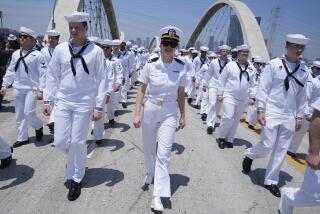Quince Street Bridge, 1905 Landmark, Reopens
- Share via
The historic Quince Street footbridge, ravaged by termites and time, reopened Tuesday after a two-year closure and a $250,000 restoration.
About 2 dozen people attended a brief ribbon-cutting ceremony at the pedestrian bridge across Maple Canyon between 3rd and 4th avenues in Hillcrest.
Built in 1905 for $805, the wooden trestle bridge was renovated in 1974 and 1981 and closed in 1987 after city engineers discovered that termites and dry rot had weakened the 236-foot structure, rendering it unsafe.
The San Diego City Council hired a consultant who recommended tearing down the bridge and either not replacing it or constructing a steel structure in its place.
But area residents, headed by Elinor Meadows, had the bridge designated a city landmark and persuaded councilmen to restore it to its original appearance.
Eighth District Councilman Bob Filner presented Meadows with a public service award for her effort to save the bridge.
“This (award) should go to everyone,” Meadows said. “A lot of people worked very hard on this (project). I only triggered it.”
The renovation, which took three months, was done by the local consulting engineering firm of Atkinson, Johnson & Spurrier. The handrails were painted Friday, and workers finished cleaning up Monday.
About 70% of the bridge was replaced with pressure-treated Douglas fir, including most of the support beams, decking and handrails, said R. Lee Biggers, one of the company’s structural engineers.
The bridge, which is 6 feet wide and 60 feet high, will need minimal maintenance, primarily periodic repainting of the handrails, said Frank Belock, deputy director of engineering design division of the city’s Department of Engineering and Development.
Belock said the bridge, whose steps are designed to support 100 pounds per square foot and the span 85 pounds per square foot, will last several decades before any more restoration will be needed.
The bridge, situated near Balboa Park, was heavily used by pedestrians for several decades, but a 1987 survey showed that fewer than 60 people used it a day.
Filner said the bridge has invaluable historic significance. There was little opposition to the city spending $250,000 from its capital improvements budget once the bridge was declared a historic landmark, and 1,000 people signed a petition and urged the council to save the structure, Filner added.
“You can’t measure its worth. It represents a different pace of life that used to be,” Filner said, adding that the bridge symbolizes the period before the automobile, when walking was more common.
Filner said the figure of 60 users a day was an underestimate and that use would increase when the public learns the structure has been reinforced.
After the ribbon-cutting, people walked to the bridge’s center and admired the view of the winding canyon, which is filled with cactus, palms, bamboo and scrub brush and dotted with litter. A utility road cuts through the middle. Homeless people camp in the canyon brush. A small part of the San Diego Bay is visible to the west.
When the bridge closed in 1987, Meadows, 75, a retired teacher whose home is at the canyon’s edge, hung large cardboard tears from the trestle to symbolize people’s sentimental ties with the structure and their concern for its destiny. For Tuesday’s ceremony, she hung a giant cardboard smile on the bridge.
“I didn’t think I would see this day,” said the native San Diegan. “It is old, but it is useful, and it would have been a shame to tear it down.”
The Quince Street footbridge is one of the city’s few remaining wooden pedestrian bridges. The Vermont Street footbridge, which spanned Washington Street in Hillcrest and led to the former site of Sears, was torn down in 1980.
Still standing is the Spruce Street Suspension Bridge, a steel cable and support structure built in 1922 and renovated in 1986.
The Quince Street footbridge, designed by city engineer George A. d’Hemecourt in 1905, was built at the request of residents who wanted better access to the trolley line that ran on 4th Avenue.
More to Read
Sign up for Essential California
The most important California stories and recommendations in your inbox every morning.
You may occasionally receive promotional content from the Los Angeles Times.













